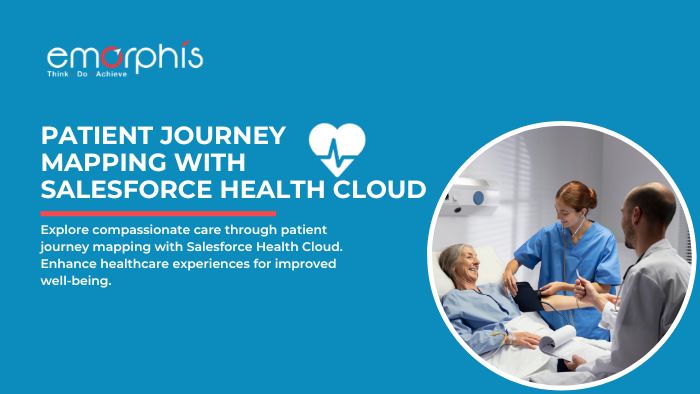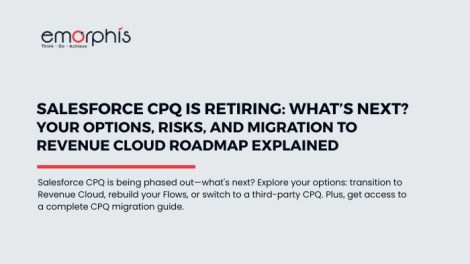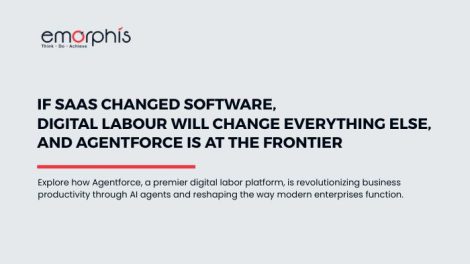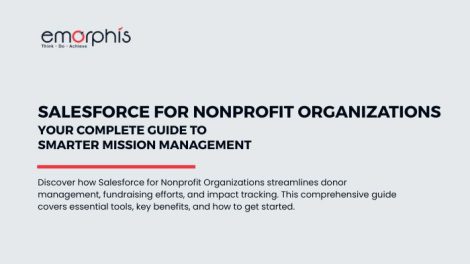Nowadays, providing exceptional patient care is no longer a mere aspiration but a critical business imperative, especially with the increasing emphasis on patient journey mapping. Moreover, patients have become more discerning consumers, demanding not just effective treatment but also a seamless and personalized experience throughout their healthcare journey.
Patient journey mapping, a strategic approach to understanding the patient's experience from their initial awareness of a need to their post-treatment follow-up, has emerged as a powerful tool. Additionally, it enables healthcare organizations to enhance patient satisfaction, improve outcomes, and drive business growth.

This comprehensive guide delves into the intricacies of patient journey mapping and also explores how Salesforce Health Cloud, a leading cloud-based healthcare platform, empowers healthcare organizations. Furthermore, it demonstrates how to create and implement effective healthcare customer journey map strategies.
What is Patient Journey Mapping?
Patient Journey Mapping is a visual representation of the patient experience across various touchpoints and interactions with the healthcare system.
Moreover, it involves tracking a patient's progression from the initial awareness of a health concern through the entire continuum of care, including treatment, recovery, and follow-up.
This healthcare journey map also provides a comprehensive view of the patient's emotions, needs, and challenges at each stage. It further, allows healthcare providers to tailor their services to meet those specific requirements.
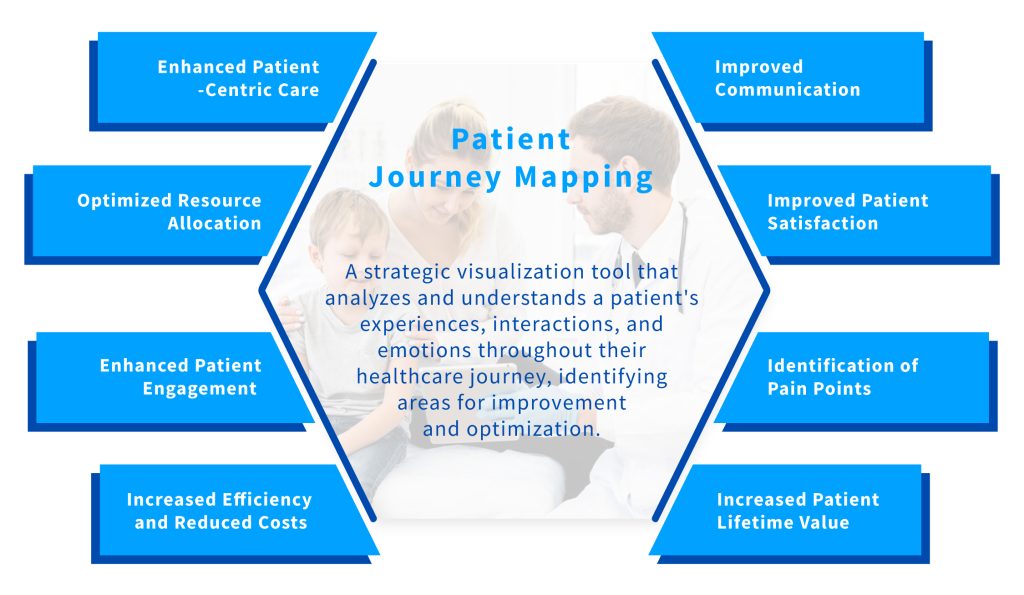
Importance of Understanding the Patient Experience
Understanding the patient experience is more than just a buzzword; it's a fundamental aspect of delivering patient-centric care. Furthermore, by delving into the intricacies of each phase of the patient experience journey map, healthcare providers can gain profound insights into the emotions, expectations, and pain points of their patients.
This understanding is instrumental in fostering patient satisfaction, loyalty, and trust, ultimately contributing to improved health outcomes. Moreover, a positive patient experience is linked to increased patient engagement, adherence to treatment plans, and a greater likelihood of recommending the healthcare provider to others.
Benefits of Patient Journey Mapping for Healthcare Providers
- Enhanced Patient-Centric Care
- Improved Communication between patients and healthcare teams
- Optimized Resource Allocation within healthcare organizations
- Improved patient satisfaction and loyalty
- Patient engagement and adherence to treatment strategies have improved
- Identification of pain points and areas for improvement in care delivery
- Increased efficiency and reduced costs
- Increased Revenue and Patient Lifetime Value
Patient Journey Vs Patient Journey Mapping
Patient journey refers to the actual experience a patient has when interacting with the healthcare system, from the moment they become aware of a need for care to the post-treatment follow-up. It encompasses all the touchpoints, interactions, and emotions that patients experience throughout their care journey.
Patient journey mapping, on the other hand, is a strategic tool used to visualize and understand the patient journey. It involves creating a visual representation of the patient's experience, identifying pain points and opportunities for improvement, and developing strategies to enhance the overall healthcare system design.
| Features | Patient Journey | Patient Journey Mapping |
| Definition | The actual experience a patient has when interacting with the healthcare system. | A strategic tool used to visualize and understand the patient journey. |
| Focus | Patient's perspective, emotions, and interactions. | Identifying pain points, opportunities for improvement, and strategies for optimization. |
| Outcome | Improved patient satisfaction, better outcomes, and increased profitability. | Enhanced understanding of patient experience, leading to better care delivery and improved patient outcomes. |
Stages of Patient Journey Mapping
Patient Journey Mapping unfolds across various stages, each playing a pivotal role in shaping the overall healthcare experience. Let's delve into these stages to understand the nuances of the patient's journey.
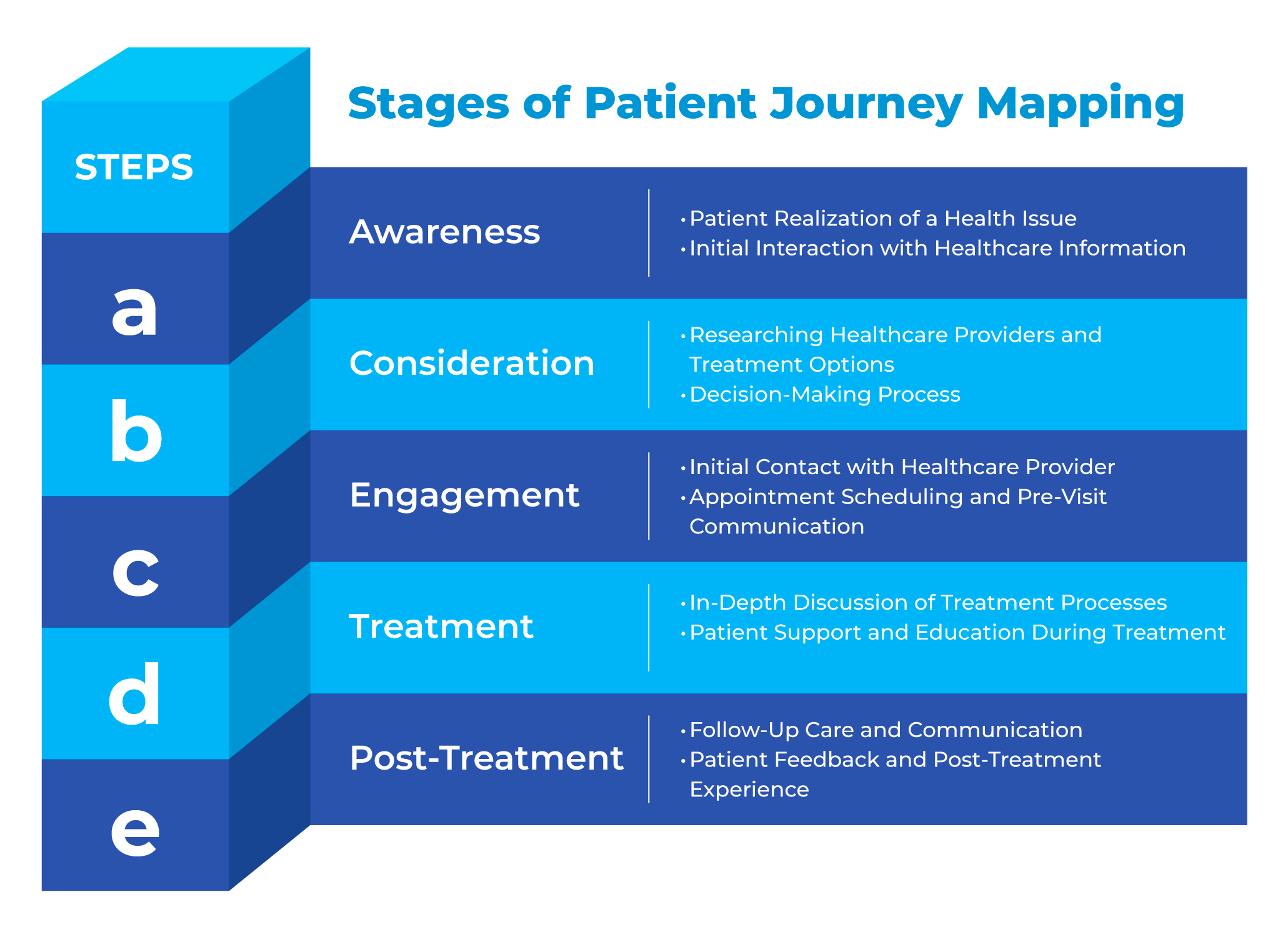
A. Awareness
1. Patient Realization of a Health Issue
The healthcare customer journey mapping commences with the patient's realization of a health concern. Simultaneously, this awareness may stem from symptoms, routine check-ups, or external factors. Furthermore, Patient Journey Mapping captures the emotional and informational needs at this early stage, providing insights into the initial concerns and questions patients may have.
2. Initial Interaction with Healthcare Information
As patients become aware of their health issues, they seek information. Subsequently, this stage involves interactions with various sources such as online resources, social media, or discussions with friends and family. As a matter of fact, mapping this phase illuminates the channels through which patients acquire information and the factors influencing their decision-making process.
B. Consideration
1. Researching Healthcare Providers and Treatment Options
Once aware, patients move into the consideration phase. Furthermore, they embark on a journey of researching healthcare providers and treatment options. In fact, Patient Journey Mapping in this stage reveals the criteria patients use to evaluate providers, the significance of reviews, and the factors influencing their decision-making.
2. Decision-Making Process
In the decision-making process, patients weigh the pros and cons, assessing the potential impact of their choice on their health also well-being. Simultaneously, Patient Journey Mapping here unveils the emotional aspects of decision-making, helping healthcare providers understand the patient's mindset and tailor information to address concerns.
C. Engagement
1. Initial Contact with Healthcare Provider
With a decision made, patients initiate contact with the chosen healthcare provider. Concurrently, this phase involves the first interaction with the healthcare system, and patient experience mapping sheds light on the expectations and anxieties of patients during this crucial point.
2. Appointment Scheduling and Pre-Visit Communication
Efficient appointment scheduling and clear pre-visit communication are integral also a must-have solutions to positive patient experiences. Furthermore, Patient Journey Mapping at this stage identifies potential friction points in the process, allowing healthcare providers to streamline scheduling systems and enhance communication strategies.
D. Treatment
1. In-depth discussion of Treatment Processes
The treatment phase involves detailed discussions between healthcare providers and patients. Additionally, Patient Journey Mapping here provides insights into how patients comprehend treatment information, the importance of shared decision-making, and the support required for informed choices.
2. Patient Support and Education During Treatment
Continuous support and education are vital components of the treatment stage. Additionally, the healthcare journey map helps identify opportunities for providing additional resources, educational materials, and emotional support, fostering a collaborative approach to healthcare.
E. Post-Treatment
1. Follow-Up Care and Communication
Post-treatment care is critical for sustained well-being. Moreover, Patient Journey Mapping in this stage highlights the expectations patients have for follow-up care, the effectiveness of communication, and the role of ongoing support in their recovery journey.
2. Patient Feedback and Post-Treatment Experience
Gathering patient feedback and assessing the post-treatment experience completes the journey. Furthermore, the healthcare journey map uncovers areas for improvement, measures patient satisfaction, and informs strategies for enhancing the overall patient experience.
Salesforce Health Cloud - A Powerful Tool for Patient Journey Mapping
Salesforce Health Cloud, a comprehensive cloud-based platform designed specifically for healthcare organizations, provides a powerful toolkit for patient journey mapping.
Its key strengths include:
- Centralized data repository: Health Cloud consolidates patient data from various sources, including electronic health records (EHRs), patient portals, and surveys. As a result, it provides a holistic view of the patient's journey.
- Seamless collaboration: Health Cloud facilitates collaboration among healthcare providers. Therefore, it enables them to share information and coordinate care effectively.
- Data analysis and visualization tools: Health Cloud provides advanced analytics tools to uncover trends, identify patterns, and gain actionable insights from patient data. Additionally, these insights empower healthcare providers to make informed decisions and optimize patient care.
How Salesforce Health Cloud facilitates the mapping of patient journeys
Salesforce Health Cloud helps healthcare providers map patient journeys by:
- Collecting patient data - Salesforce Health Cloud collects patient data from different sources like lab results, EHRs, and patient history.
- Using the Patient Caregiver Map - Healthcare providers can also use the Patient Caregiver Map to map relationships to specialists and other providers involved in a patient's care. Simultaneously, they can also map household relationships.
- Using the Timeline view - The Timeline view, in fact, presents patient information in chronological order, which helps care coordinators understand a patient's health profile.
- Household mappings - These mappings provide insights into a patient's home life, needs, also goals.
Step-by-Step Guide to Patient Journey Mapping with Salesforce Health Cloud
Implementing patient journey mapping with Salesforce Health Cloud involves a structured approach. Hence here is the step-by-step guide to empower you with the Salesforce Health Cloud to attain Patient Journey Mapping.
Step 1: Define patient personas and their unique journey paths
- Identify distinct patient groups based on demographics, healthcare needs, and preferences.
- Map out the typical journey path for each persona, considering touchpoints, emotions, and pain points.
Step 2: Gather data from various sources
- Collect patient feedback through surveys, interviews, also focus groups.
- Analyze patient interactions with the healthcare system, including appointment schedules, clinical records, also patient portal usage.
- Review patient complaints and compliments to identify recurring issues and areas for improvement.
Step 3: Analyze and visualize the data
- Use Health Cloud's analytics tools to organize, analyze, and visualize patient data.
- Identify trends, patterns, and correlations between patient characteristics, touchpoints, and outcomes.
- Uncover pain points and areas where patient satisfaction can be improved.
Step 4: Develop action plans to address pain points and improve the patient experience
- Prioritize pain points based on their impact on patient satisfaction and outcomes.
- Develop action plans to address identified pain points, such as streamlining processes, providing additional training to staff, or implementing new technologies.
- Assign ownership and track progress on action plan implementation.
Want to implement Salesforce Health Cloud to deliver a better patient experience? Check out how our Salesforce Implementation Services can help.
How does Salesforce help you manage patient relationships?
Let’s explore how Salesforce Health Cloud helps you manage patient relationships from initial acquisition, service, care management, and moreover ongoing engagement.
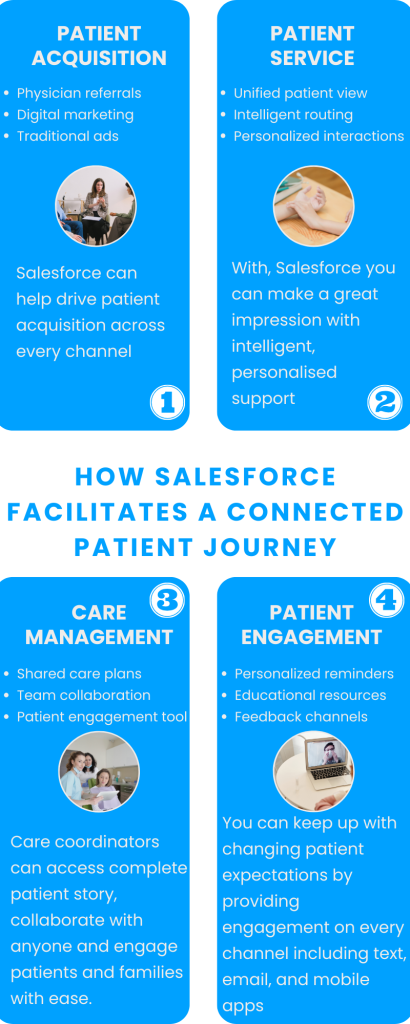
1. Patient Acquisition
In the healthcare patient journey, Salesforce Health Cloud helps healthcare organizations attract new patients and also referrals through various channels, including:
- Physician referrals: Health Cloud enables seamless communication and collaboration between physicians. Also, facilitating patient referrals and ensuring a smooth transition of care.
- Digital marketing: Provides targeted marketing tools to reach potential patients based on their demographics, health needs, and interests. Also, helps in driving traffic to the organization's website or patient portal.
- Traditional ads: Salesforce Health Cloud integrates with traditional advertising campaigns. Consequently, organizations can track the effectiveness of their ads and measure their impact on patient acquisition.
2. Patient Service
Salesforce Health Cloud empowers healthcare organizations to deliver exceptional, personalized patient service, optimizing experiences throughout the healthcare patient journey. Key features include:
- Unified patient view: A centralized repository of patient data, including medical history, appointment schedules, and insurance information, ensures a holistic view of each patient. Consequently, this enables representatives to address inquiries effectively, fostering a more personalized and efficient patient experience.
- Intelligent routing: Health Cloud's AI-powered routing system automatically directs patient calls or inquiries to the most qualified representative. Resulting in reducing wait times and improving resolution rates.
- Personalized interactions: Health Cloud enables representatives to personalize interactions with patients. Additionally, by leveraging patient data and insights, they can tailor conversations and provide relevant information.
3. Care Management
In the context of the healthcare patient journey, Salesforce Health Cloud streamlines care management by facilitating collaboration and providing a comprehensive overview of patient care. Key features include:
- Shared care plans: Health Cloud enables the creation and sharing of care plans among providers, patients, and family members. Also, ensuring consistent and coordinated care delivery.
- Team collaboration: Health Cloud provides a secure platform for care team members to communicate, share updates, and assign tasks. Also, it ensures seamless coordination and efficient care delivery.
- Patient engagement tools: Salesforce Health Cloud empowers patients to actively participate in their care by providing access to their health records, appointment scheduling, and more, secure messaging with providers.
4. Patient Engagement
Salesforce Health Cloud facilitates the healthcare patient journey and promotes proactive patient engagement through various channels, fostering patient satisfaction and adherence to care plans. Key features include:
- Personalized reminders: Health Cloud sends personalized reminders to patients about upcoming appointments, medication refills, also preventive care screenings, promoting timely care and adherence to treatment plans.
- Educational resources: Health Cloud provides patients with access to educational resources and self-care tools. Also, empowering them to make informed decisions about their health and manage their conditions effectively.
- Feedback channels: Salesforce Health Cloud integrates feedback mechanisms, such as surveys and patient portals. This allows patients to share their experiences and provide valuable insights for continuous improvement.
Overall, Salesforce Health Cloud facilitates a connected healthcare patient journey by streamlining interactions, promoting collaboration, and empowering patients to take an active role in their care. In essence, this holistic approach enhances patient satisfaction, improves outcomes, and contributes to the success of healthcare organizations.
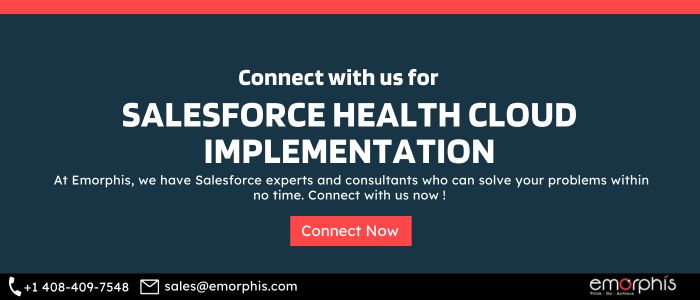
Conclusion
Salesforce Health Cloud is a perfect tool for healthcare organizations for Patient Journey Mapping, it optimizes care delivery, enhances satisfaction, and elevates outcomes.
So, are you ready to transform your organization? Explore our Salesforce Implementation Services to implement Health Cloud and embark on a patient-centric journey for better healthcare delivery.
Contact us today!



